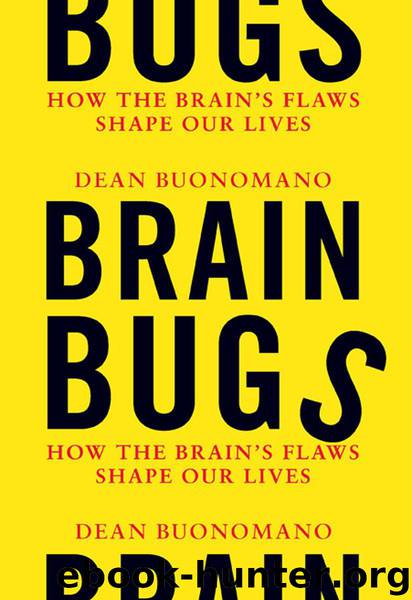Brain Bugs: How the Brain's Flaws Shape Our Lives by Dean Buonomano

Author:Dean Buonomano
Format: mobi, epub
Tags: Life Sciences, Human Anatomy & Physiology, Neuropsychology, Memory - Physiological aspects, Science, Medical, Physiological Psychology, Brain, Memory, Neuroscience, Brain - Physiology, Physiological aspects, Physiology, Psychology
ISBN: 9780393076028
Publisher: W.W. Norton
Published: 2011-07-10T16:00:00+00:00
2. G-R-G-R-R-R
3. G-R-R-R-R-R
Which would you choose? When Kahneman and Tversky performed this experiment, 65 percent of the college students in the study picked sequence 2, and only 33 percent correctly picked sequence 1.19 We know that G is the most likely outcome of any single roll (2/3 probability versus 1/3 probability), so we expect fewer Rs. Most people seem to favor sequence 2 because at least it has two Gs; however, the significance of the fact that there are fewer elements in sequence 1 is often missed: any specific sequence of five rolls is more likely than any given sequence of six rolls. And sequence 2 is sequence 1 with a G in front of it. So if we calculated the probability of sequence 1, P(1) = 1/3 × 2/3 × 1/3 × 1/3 × 1/3, the likelihood of sequence 2 has to be less: 2/3 × P(1).
Which brings us to the conjunction fallacy. The probability of any event A and any other event B occurring together has to be less likely than (or equal to) the probability of event A by itself. So, as remote as it is, the probability of winning the Lotto in tomorrow’s draw is still higher than the probability of winning the Lotto and of the sun rising. We are suckers for conjunction errors. What do you think is more likely to be true about my friend Robert: (A) he is a professional NBA player, or (B) he is a professional NBA player and is over six feet tall? For some reason option B seems more plausible, even though the probability of B must be less than (or equal to) the probability of A.20 And speaking of basketball, there is a particularly severe epidemic of conjunction fallacies in the arena of sports. Sportscasters offer a continuous stream of factoids such as “He’s the first teenager in the last 33 years with three triples and two intentional walks in one season”21 or “He’s the first to throw for three touchdowns on a Monday night game with a full moon on the same day the Dow Jones fell more than 100 points.” Okay, that last one I made up. But my point is that as conditions are added to a statement (more conjunctions), the less likely any set of events is. The conjunction fallacy allows sportscasters to feed the illusion that we are witnessing a one-of-a-kind event by adding largely irrelevant conjunctions—and in doing so increase the likelihood we will stay tuned in.
The Monty Hall problem provides perhaps the best-known example of the inherent counterintuitiveness of probability theory. In the early nineties the Monty Hall problem created a national controversy, or at least as much of a controversy as a brain teaser has ever generated. In 1990 a reader posed a question to the Parade magazine columnist Marilyn vos Savant. The question was based on the game show Let’s Make a Deal, hosted by Monty Hall. Contestants on the show were asked to pick one of three
Download
Brain Bugs: How the Brain's Flaws Shape Our Lives by Dean Buonomano.epub
This site does not store any files on its server. We only index and link to content provided by other sites. Please contact the content providers to delete copyright contents if any and email us, we'll remove relevant links or contents immediately.
The Art of Thinking Clearly by Rolf Dobelli(10126)
Mindhunter: Inside the FBI's Elite Serial Crime Unit by John E. Douglas & Mark Olshaker(9094)
Change Your Questions, Change Your Life by Marilee Adams(7552)
Nudge - Improving Decisions about Health, Wealth, and Happiness by Thaler Sunstein(7450)
Mastermind: How to Think Like Sherlock Holmes by Maria Konnikova(7149)
The Power of Now: A Guide to Spiritual Enlightenment by Eckhart Tolle(5523)
Men In Love by Nancy Friday(5104)
Altered Sensations by David Pantalony(4996)
Factfulness: Ten Reasons We're Wrong About the World – and Why Things Are Better Than You Think by Hans Rosling(4618)
The Confidence Code by Katty Kay(4150)
Thinking in Bets by Annie Duke(4113)
Man and His Symbols by Carl Gustav Jung(4002)
The Worm at the Core by Sheldon Solomon(3391)
Why Buddhism is True by Robert Wright(3366)
Three Women by Lisa Taddeo(3317)
Liar's Poker by Michael Lewis(3313)
The Inner Life of Animals by Peter Wohlleben(3188)
Descartes' Error by Antonio Damasio(3183)
The Power of Mindful Learning by Ellen J. Langer(3126)
